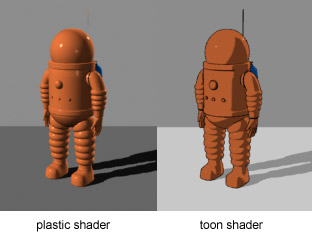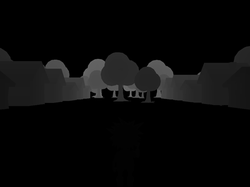Cel shading: Difference between revisions
InternetMeme (talk | contribs) Added creative source. |
See also |
||
| Line 37: | Line 37: | ||
==References== |
==References== |
||
{{Reflist}} |
{{Reflist}} |
||
==See also== |
|||
*[[List of cel-shaded video games]] |
|||
==External links== |
==External links== |
||
Revision as of 00:41, 17 January 2011
This article needs additional citations for verification. (March 2009) |

Cel-shaded animation (also known as Cel shading or Toon shading) is a type of non-photorealistic rendering designed to make computer graphics appear to be hand-drawn. Cel-shading is often used to mimic the style of a comic book or cartoon. It is a somewhat recent addition to computer graphics, most commonly turning up in video games. However, the end result of cel-shading has a very simplistic feel like that of hand-drawn animation. The name comes from the clear sheets of acetate, called cels, which are painted on for use in traditional 2D animation, such as Disney classics.[1]
Process
The cel-shading process starts with a typical 3D model. Where cel-shading differs from conventional rendering is in its use of non-photorealistic lighting. Conventional (smooth) lighting values are calculated for each pixel and then mapped to a small number of discrete shades to create the characteristic flat look – where the shadows and highlights appear more like blocks of color rather than mixed in a smooth way.
Black "ink" outlines and contour lines can be created using a variety of methods. One popular method is to first render a black outline, slightly larger than the object itself. Backface culling is inverted and the back-facing triangles are drawn in black. To dilate the silhouette, these back faces may be drawn in wireframe multiple times with slight changes in translation. Alternately, back-faces may be rendered solid-filled, with their vertices translated along their vertex normals in a vertex shader. After drawing the outline, back-face culling is set back to normal to draw the shading and optional textures of the object. Finally, the image is composited via Z-buffering, as the back-faces always lie deeper in the scene than the front-faces. The result is that the object is drawn with a black outline and interior contour lines. Popularly, this "ink" outline applied to animation and games is what’s called cel shading, while originally the term referred to the shading technique, regardless of whether outline is being applied or not.
The Utah teapot rendered using cel-shading:
- The back faces are drawn with thick lines
- The object is drawn with a basic texture
- Shading
Steps 2 and 3 can be combined using multi-texturing (see texture mapping).
Another outlining technique is to use 2D image-processing. First, the scene is rendered (with cel-shading) to a screen-sized color texture:
Then, the scene's depth and world-space surface normal information are rendered to screen-sized textures:
A Sobel filter or similar edge-detection filter is applied to the normal/depth textures to generate an edge texture. Texels on detected edges are black, while all other texels are white:
Finally, the edge texture and the color texture are composited to produce the final rendered image:
References
- ^ Celshader.com FAQ Retrieved August 2, 2005.
See also
External links
- CelShading.com. More information on 3D cel-shading including an image gallery.
- Shirowproject.com. filmic quality cel shaded project inspired by Ghost in the Shell
- IGN: Jet Set Radio review. Retrieved August 4, 2005.
- GameDev.net - Cel-Shading. Retrieved August 5, 2005.






